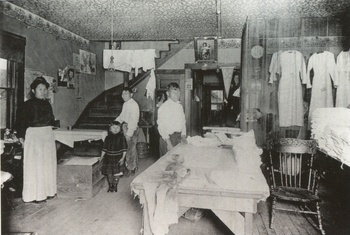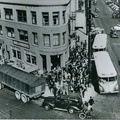Read Part 1 >>>
When the women finally arrived in Fowler, they found a thriving Japanese community dominated by the interests of a predominantly male population. Like many towns in the county, Fowler’s Japanese community was situated on “the other side of the tracks” along with the Chinese who had settled there before them, and who, in the 1870s numbered five hundred, the largest immigrant group in Fresno County. Racial antagonism had compelled the Japanese and Chinese, as well as other ethnic minorities (German-Russians, Italians, and Armenians) to live in separate “colonies” that met the economic, social, and spiritual needs of their own communities.1 A leisurely walk down the main streets of Fowler’s Japanese community found thirteen business establishments (nine Japanese and four Chinese) four boarding houses, three pool rooms, three restaurants, and one barber shop,2 the numbers and kinds of establishments reflecting, in part, the character of the population that sustained them.
Mrs. Abe’s first glimpse of Fowler was on the fourth of July, 1911. “It was very hot. One hundred and ten degrees in the shade! The women were wearing dresses and carrying shovels on their shoulders. During those days that’s how all the women went to work—they didn’t wear pants. My husband dropped me off at a sewing school by the Buddhist church and left me there. He went to Stockton to look for a job since he worked there before. When he returned, we went to live at the Nakayama’s on the side of a barn. The horses stayed on one side, we slept on the other. In the morning Mrs. Nakayama asked me, “Did you sleep all right?” I answered, ‘I couldn’t sleep a wink because the smell of the manure nauseated me so much.’ She smiled and patted me on the back. ‘Oh, congratulations! You are in a family way!” I was so embarrassed. The next day we moved into the tank house and it was much better. We used several sweat boxes for a bed, one sweat box with four legs pounded into it for a table, one hug box for a chair, a pan, two rice bowls, and two plates—that’s all we owned, so it was easy to move.”
The women quickly discovered that America was not nearly as idyllic as they had imagined. “I used to see the men who returned from America sporting shiny gold chains and watches—the ladies wearing sparkly combs in their hair,” Mrs. Abe reminisced. The riches she saw made her want to come to America, a but what she found instead were appalling living conditions, hard physical work, a hostile community, and a husband who dominated almost every sphere of her daily existence. During the first several decades after the women’s arrival, the summer heat, unsanitary conditions, malaria, typhoid, and dysentery took the lives of thousands of Japanese in Fresno County.”3
But loneliness and despair were perhaps greater adversities than the harsh external environment. Mrs. Abe’s eyes misted as she remembered the loneliness that embraced her during those early years, “I used to wonder, why did I ever want to come to such a filthy place” When night came, we ate dinner by kerosene lamps—even in Mita we had lights. And every time I heard the whistle of a train, I wanted to just board that train and go back home. When the quails cried, ‘Okaa-ka, Okaa-ka’ it really made me lonesome. Even the birds were crying, ‘Mama, Mama.’ When I gazed up at the moon, I would think of my family in Japan looking up at the same moon, and I would cry.”
Going back to Japan was a hope that consumed the thoughts of many of the women for the first few years of their stay, but with the birth of each child, the dreams slowly faded. “Those who were able to save and conserve, they were the ones who went home,” claimed Mrs. Sato. But even though her husband did not drink and gamble, the Satos never did have enough to make ends meet.
Mrs. Sato’s husband was unusual, according to Mrs. Abe, because many of the men engaged in gambling and drinking, activities that occupied their bachelor days when Japanese women were a rare commodity to find. “Do you remember Takagi-san?” She asked Mrs. Sato, who shook her head knowingly. “Well, her husband used to gamble and drink almost nightly. He would come home with Levi labels that he tore off the pants’ pockets and give them to her. These are bank checks’ he’d tell her, ‘so put them away in a safe place.’ One day a friend came over and she proudly showed them off. ‘Look at all these checks that my husband gave me to put away,’ she boasted. Well, the truth came out: They weren’t worth a cent!”
During the early 1900s the most popular places for men to gather after work were the gambling halls which were secretly managed in the back rooms of boarding houses and general merchandise stores. As more of the Japanese laborers lost their entire seasonal wages in these halls and more negative attention emanated from the local press and law enforcement agencies, a concerted effort arose from within the Japanese communities to shut them down.
Fowler’s Japanese community banned together to stamp out the Chinese gambling houses and to improve their image as law-abiding citizens. In 1912, a group of Japanese businessmen met with the city’s board of trustees and presented them with a petition, signed by seventeen businessmen, asking the board to appoint an assistant marshal and a night watchman, whose salaries they were willing to pay, in order to close down the Chinese gambling houses in their community. Mr. Hashioka, the group’s spokesman, reported that his countrymen lost approximately $20,000 to $30,000 to the keepers of these halls. He claimed that many of the transient laborers would come into town with only $50 to $100, run up big bills with the local merchants and boardinghouse keepers, lose all their season’s earnings to the Chinese gambling houses, then skip town. But the trustees took no action on their petition, deciding it was a matter of race rivalry between the Chinese and Japanese.4 Their decision presaged the continuation of the gambling halls, and until the end of the decade, the Japanese faced attacks from the local press and law enforcement agencies for violating liquor laws and engaging in gambling and “immoral” conduct.
The greatest forces that helped rid the town of gambling and prostitution and alter the direction of community life were the gradual increase of the Issei women and the birth of the second generation. The start of family life ushered in a bountiful period of social and economic growth in Fowler’s Japanese community with the focus of activities centered around the youth and directed toward promoting community and cultural cohesion. The central organizing force in the community was Fowler’s Buddhist Church, a Japanese Community Hall built in 1915 by the Doo-shin-kai (Japanese Association comprised mainly of Issei from Hiroshima prefecture), serving as the focal point for religious and social activities. The hall, destroyed by fire in 1930 and built anew the following year, housed the community’s multiple activities, such as Sunday school classes, church services, Japanese language school, Japanese cooking and flower arrangement classes, plays, and other social functions.5
But the birth of their children did not give the women a reprieve from their economic responsibilities. “We all worked in the fields, even after the children came,” said Mrs. Abe, her voice low and raspy. “My, how the Issei all suffered… when I think back about when we first came to America, I’m really amazed at what we went through. I remember when Kay Morimoto was a little girl; she would come home from school and yell out to her mother, “What shall I wear?” And her mother would shout back, ‘Go naked!’ The mother worked so hard, carrying cantaloupes in huge gunnysacks. When I went to their house, they had a couple of five-gallon cans with wire strung through the sides for handles. They’d cook rice in one can and use the other for tea, then they’d go right back out to work again, still biting on their food as they headed for the fields.”

Kings Hand Laundry - Hanford, California, ca. 1916. Gift of Naomi Tagawa, Japanese American National Museum (93.24.4)
Two of the interviewed women said that their work was limited to childrearing, household chores, and occasional light farm tasks, but they both agreed that they were among the few who did not have to engage in hard physical labor. Most of the families counted heavily on the financial contributions made by the women, a role in which they took great pride. Many of the women, however, also expressed regret that work prevented them from spending more time with their children.
“My children…I don’t deserve their kindness.” Reflected Mrs. Abe, remorsefully. “I didn’t raise them; they grew up by themselves. I would return for an hour to make lunch, feed the kids, change their diapers, and put water in their bottles.” Her face lit up in a smile. “Sadako. She was smart. She’d grab my legs and wouldn’t let go. She hated to see us leave.”
In order to manage work and childrearing at the same time, the women oftentimes helped to tend each other’s children. Mrs. Abe recalled: “When we lived next to the Shimizu’s, the missus and I would take turns coming home to feed the babies. One time I couldn’t find Kenji. We panicked and looked all over when we heard a baby’s cry. He had fallen off the bed, next to the wall. What a relief! After the children grew a little bigger, we put a fence around the house so they couldn’t get out.”
But despite the worries and hardships, Mrs. Abe remembered those early childrearing days with great fondness. “Ah, yes,” she smiled. “On Sundays we had all those dirty diapers to wash. They wouldn’t get clean so we had to boil the clothes in soapy water and hand scrub each. My husband would be taking a nap, hollering at us because he couldn’t rest in peace with all the hustle and bustle. After the wash, I got lunch ready for the next day, then my husband would start bathing the children and hollering around again, ‘Come after the baby!’ I would go after one, lay him naked on the bed, then go after the next, and the next.” She laughed good-naturedly. If I worked that hard in Japan, we would have had an easy life.” “Ah…but those were the good times, neh?” Mrs. Sato sighed.
Mrs. Abe continued to reminisce:” And whenever friends came over, we’d quickly kill a chicken, make umani (fish and vegetables boiled with soy sauce and sugar), and everyone would eat together and have a great time. We never do that anymore.”
Notes:
1. House Immigration Commission, Immigrants in Industries, 664-668, and Edward K. Strong, "Japanese in California," Education Psychology 1: 2 (1933): 13-17.
2. "Fowler Business Licenses; Who Pays License, What for and How Much; Interesting Figures," Fowler Ensign, 19 March, 1910.
3. Yuji Ichioka, "A Buried Past: Early Issei Socialists and the Japanese Community," Amerasia Journal 1: 2 (July 1971), 8; and the House Commission on Immigration and Naturalization, Hearings: Japanese Immigration (66th Congress, 2d sess., 1921), 778.
4. "Trustees Turn Down Petition of Japanese Merchants and Transact Other Business," Fowler Ensign, 24 August, 1912.
5. Buddhist Churches, 450-453.
© 2005 Akemi Kikumura Yano





